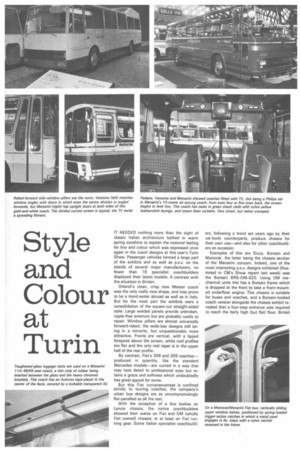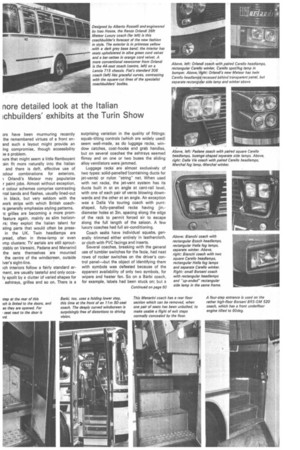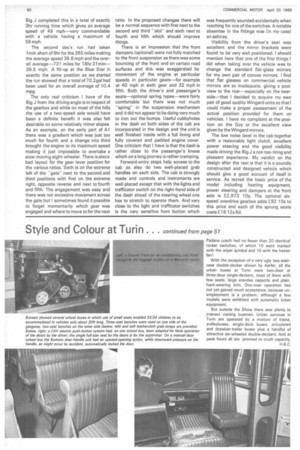Style and Colour at Turin
Page 52

Page 53

Page 62

If you've noticed an error in this article please click here to report it so we can fix it.
IT NEEDED nothing more than the sight of classic Italian architecture bathed in warm spring sunshine to explain the national feeling for line and colour which was expressed once again in the coach designs at this year's Turin Show. Passenger vehicles formed a large part of the exhibits and as well as p.s.v. on the stands of several major manufacturers, no fewer than 18 specialist coachbuilders displayed their latest models. A contrast with the situation in Britain.
Orlandi's clean, crisp new Meteor coach was the only really new shape, and may prove to be a trend-setter abroad as well as in Italy. But for the most part the exhibits were a consolidation of the square-cut straight-sided style. Large welded panels provide unbroken, ripple-free exteriors but are probably costly to repair. Window pillars are almost universally forward-raked, the wide-bay designs still being in a minority, but unquestionably more attractive. Fronts are vertical, with a lipped forepeak above the screen, while roof profiles are flat and the only real taper is in the upper half of the rear profile.
By contrast, Fiat's 306 and 309 coaches— produced in quantity, like the standard Mercedes models—are curved in a way that may look dated to professional eyes but retains a grace and softness which undoubtedly has great appeal for some.
But this Fiat curvaceousness is confined strictly to touring coaches; the company's urban bus designs are as uncompromisingly flat-panelled as all the rest.
With the exception of a few bodies on Lancia chassis, the native coachbuilders showed their wares on Fiat and -OM (wholly Fiat owned) chassis; or at least on Fiat running gear. Some Italian specialist coachbuild ers, following a trend set. years ago by their car-body counterparts, produce chassis for their own use—and also for other coachbuilders on occasion.
Examples of this are Sicca, Borsani and Monocar, the latter being the chassis section of the Menarini concern. Indeed, one of the most interesting p.s.v. designs exhibited (illustrated in CM's Show report last week) was the Borsani BRS-OM-520. Using OM mechanical units this has a Borsani frame which is dropped at the front to take a front-mounted underfloor engine. This chassis is suitable for buses and coaches, and a Borsani-bodied coach version alongside the chassis exhibit revealed that a four-step entrance was required to reach the fairly high (but flat) floor. British ors have been murmuring recently the remembered virtues of a front enand such a layout might provide an ing compromise, though accessibility )13 a problem.
)urs that might seem a little flamboyant .ain fit more naturally into the Italian and there is deft, effective use of 3olour combinations for exteriors, Orlandi's Meteor may popularize r paint jobs. Almost without exception, ir colour schemes comprise contrasting ital bands and flashes, usually lined-out in black, but very seldom with the mork strips with which British coachrs generally emphasize styling patterns. it grilles are becoming a more promfeature again, mainly as slim horizonrs; they exploit the Italian talent for sting parts that would often be pressin the UK. Twin headlamps are pread, often in three-lamp or even imp clusters; TV aerials are still sprout)tably on Varesini, Padane and Menarinil the sets themselves are mounted the centre of the windscreen, outside iver's sight-line.
ich interiors follow a fairly standard arment, are usually tasteful and only occaly spoilt by a clutter of varied shapes for ashtrays, grilles and so on. There is a surprising variation in the quality of fittings: squab-tilting controls (which are widely used) seem well-made, as do luggage racks, window catches, coat-hooks and grab handles, but on several coaches the ashtrays seemed flimsy and on one or two buses the sliding alloy ventilators were jammed.
Luggage racks are almost exclusively of two types: solid-panelled (containing ducts for jet-vents) or nylon "string" net. When used with net racks, the jet-vent system has its ducts built in at an angle at cant-rail level, with one of each pair of vents blowing downwards and the other at an angle. An exception was a Dalla Via touring coach with puntshaped, fully-panelled racks having iin.diameter holes at 3in. spacing along the edge of the rack to permit forced air to escape along the full length of the saloon. A few luxury coaches had full air-conditioning.
Coach seats have individual squabs, generally trimmed either entirely in leathercloth, or cloth with PVC facings and inserts.
Several coaches, breaking with the general use of tumbler switches for the facia, had neat rows of rocker switches on the driver's control panel—but the object of identifying them with symbols was defeated because of the apparent availability of only two symbols, for wipers and heater fan. So on a Barbi coach, for example, labels had been stuck on: but a Padane coach had no fewer than 20 identical rocker switches, of which 10 were marked with the wiper symbol and 10 with the heater fan !
With the exception of a very ugly two-staircase double-decker shown by Aerfer, all the urban buses at Turin were two-door or three-door single-deckers, most of them with few seats, large standee capacity and plain, hard-wearing trim. One-man operation has not yet gained much acceptance, because unemployment is a problem, although a few models were exhibited with automatic ticket equipment.
But outside the Show there was plenty. to interest visiting busmen. Urban services in Turin are operated by a mixture of trams, trolleybuses, single-deck buses, articulated and drawbar-trailer buses plus a handful of attractive six-wheeled double-deckers. And at peak hours all are jammed to crush capacity.
1-1.B.C.
























































































































